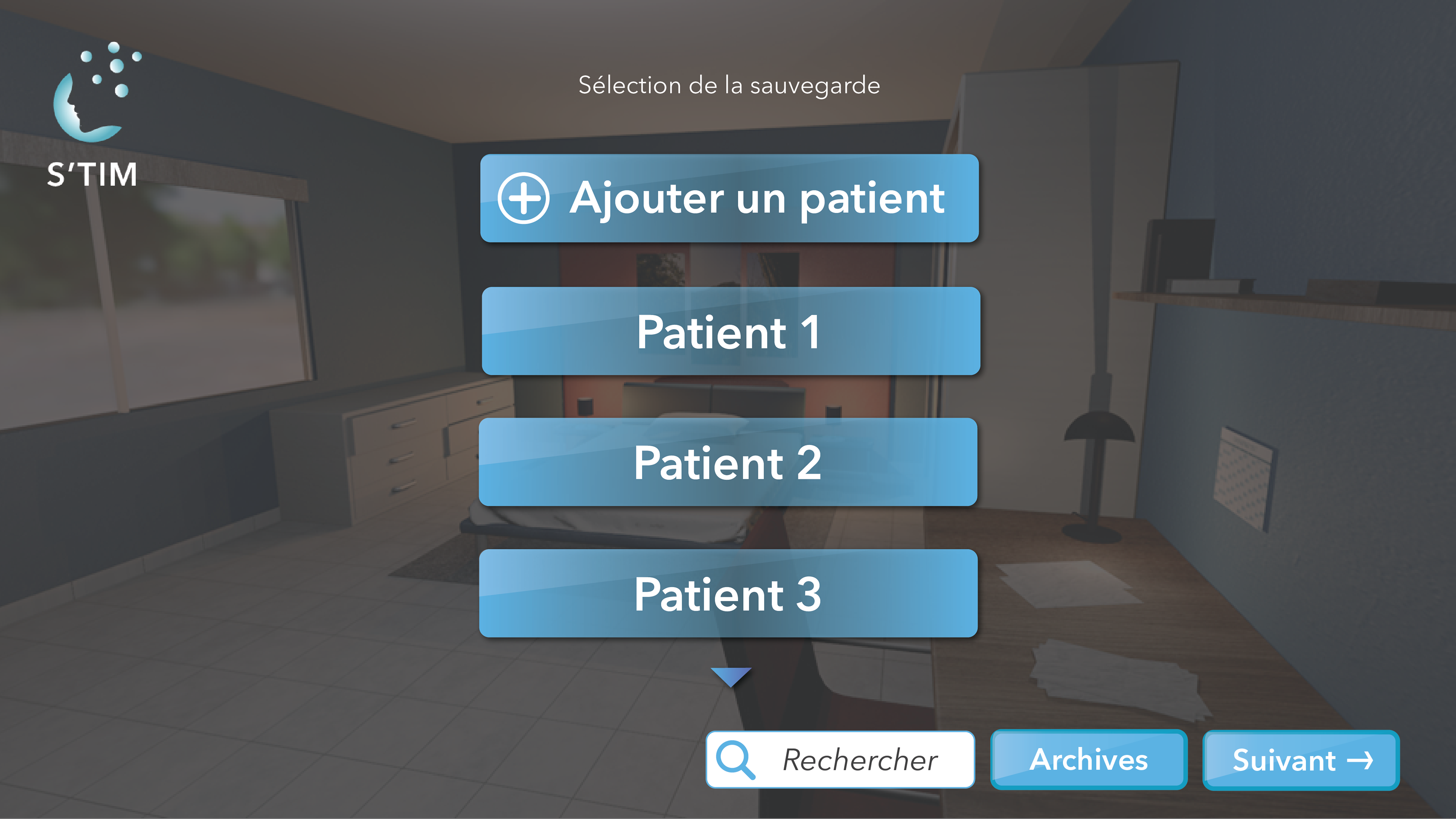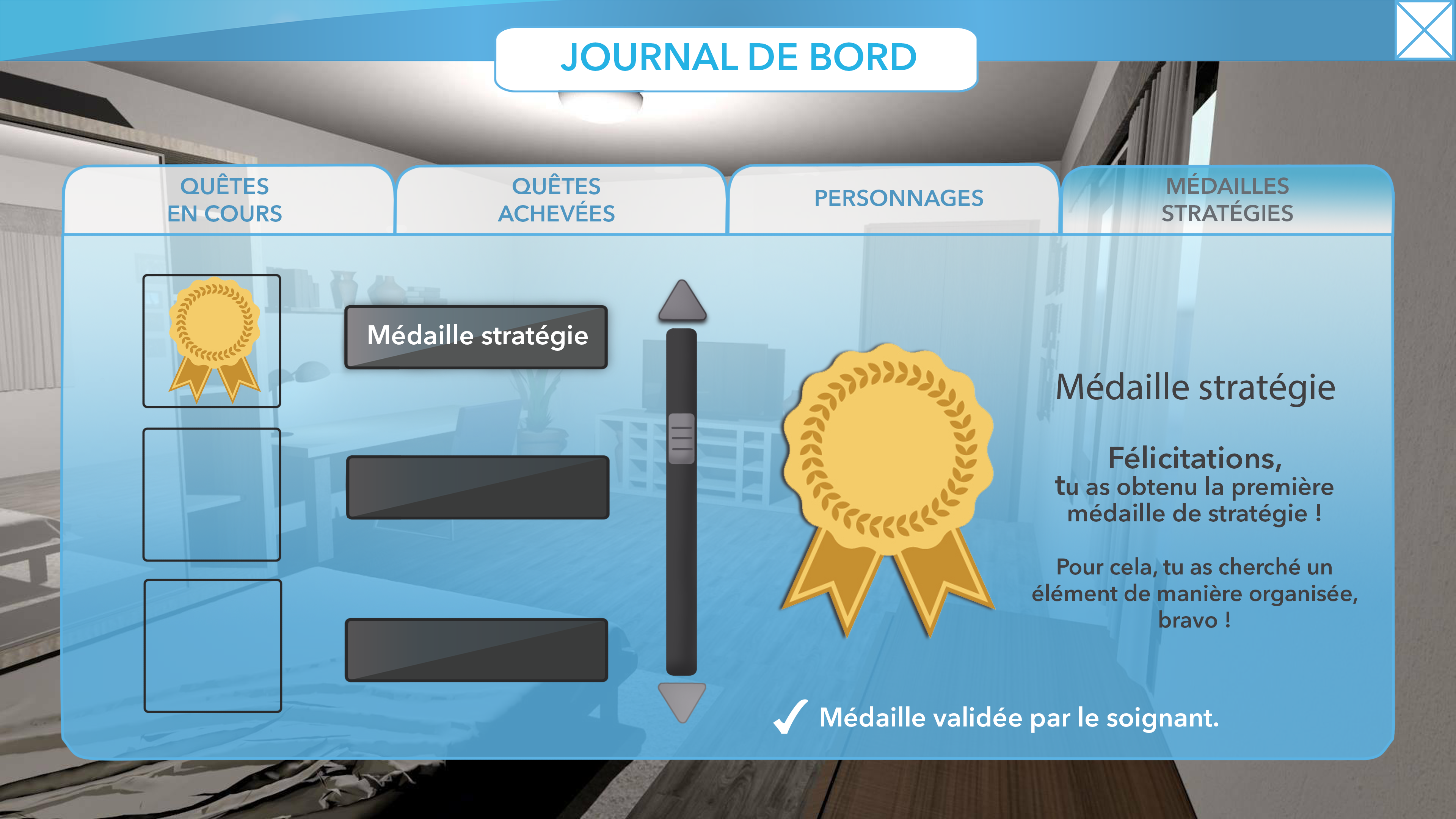1. GLOBAL MISSION & CONTEXT
"S'TIM" is a project linked to fundamental research on the impact that a serious game could have in the rehabilitation of dysexecutive behavioral disorders. Linked to the Ramsay’s clinics and I3M laboratory I participate to elaborate a functional prototype of this serious game to launch the clinical trials in real life conditions. This innovative project was rewarded by the Federation of Private Clinics and Hospitals of France in 2018.
• Organization and participation in operational steering committees
• Benchmarking
• Creation of personas after observing in-situ the users behaviors
• Writing user stories
• Realization of low fidelity models to test user behavior
• A/B testing of models in low fidelity to quantify the added value provided to users
• Argue the interfaces choices with the stakeholders based on gamification research
• Create mid-fidelity interfaces for use of the prototype in a clinical setting
• Testing with the users the interface on the Unity project
Finalization and transmission of specifications to the clinics project management
• Benchmarking
• Creation of personas after observing in-situ the users behaviors
• Writing user stories
• Realization of low fidelity models to test user behavior
• A/B testing of models in low fidelity to quantify the added value provided to users
• Argue the interfaces choices with the stakeholders based on gamification research
• Create mid-fidelity interfaces for use of the prototype in a clinical setting
• Testing with the users the interface on the Unity project
Finalization and transmission of specifications to the clinics project management
2. PROBLEMATIC AND PERSONAS
Whether it’s a car accident, a stroke, or a head trauma, each year in France 205 000 people suffer from disorders of the cognitive functions. When a person’s executive functions fail, he or she has trouble analysing, planning, organizing, scheduling, and completing tasks. People with EFD commonly lack the ability to handle frustration, start and finish tasks, recall and follow multi-step directions, stay on track, self-monitor, and balance tasks and one of the major issues during the reintegration program is that they are struggling to realise that they have a real problem. So what we can do to make the recovery program more immersive, more fun? the STIM project you are going to discover is all about helping them.
To establish the personas, I went several times to the Ramsay Group clinic in Aubagne to meet with management, doctors, occupational therapists, and the main users - the patients. Through immersion in the clinic (observing rehabilitation sessions, studying monitoring methods, understanding medical issues, etc.), I was able to create the two main personas for this serious game, which will serve as a guide for creating the user experience.
To establish the personas, I went several times to the Ramsay Group clinic in Aubagne to meet with management, doctors, occupational therapists, and the main users - the patients. Through immersion in the clinic (observing rehabilitation sessions, studying monitoring methods, understanding medical issues, etc.), I was able to create the two main personas for this serious game, which will serve as a guide for creating the user experience.

Persona 1: Patient aged 50 years or older, suffers from anosognosia, little to no experience with digital tools, may suffer from additional physical pathologies (amputation following their accident, general nervous system disorder).

Persona 2: Young occupational therapist, primarily interested in better understanding the rehabilitation process and quantifying the patient's progress.
3. WIREFRAME, MID-FIDELTY PROTOTYPE AND USER TESTING
Following various meetings within the clinic, I developed the first iterations of the user journey through design thinking meetings with the project team in plenary to ensure that stakeholders could express themselves. To fuel these meetings, I conducted various benchmarks of interfaces and game modes of competing or non-competing projects.
It was defined in the preliminary specifications that these interfaces were intended for use on a 47" touch screen that would be mounted on a medical stand to be used by bedridden patients. It was important during the design phase to keep this information in mind in my proposal.
To facilitate clinical trials, I also decided to propose two movement systems, one with direct action using a gamepad and another closer to a keyboard with directional arrows. The location of the movement system can be reversed depending on whether the user is left-handed or right-handed to facilitate work, and all parts related to the patient must be accessible from the bottom of the screen.
I worked with the development team, the clinic, and the laboratory using AGILE methodology throughout this process to ensure relevant design.
As such, I created all low-fidelity wireframes with a relational mapping between them on Adobe XD to check if we had all the necessary elements to create the prototype.
The particularly challenging point in the realization of these interfaces was identifying the need of the healthcare team to evaluate patient results on the serious game. In addition to the standard statistics, I envisioned a system based on a heat map to trace the patient's path in a top-down view, clearly identify blocking points, and relate the results obtained with the dysexecutive disorders worked on in the level in question. This idea is based on a study conducted in Canada that used this technique to improve the configuration of public buildings based on the constraints of people with disabilities.
To further fuel my reflection on this project and comply with the standards required by the laboratory and the clinic, I had to adhere to certain principles of gamification specific to serious games as specified by Julian Alvarez (access to rewards, a system for quantifying acquired knowledge, etc.).
To further fuel my reflection on this project and comply with the standards required by the laboratory and the clinic, I had to adhere to certain principles of gamification specific to serious games as specified by Julian Alvarez (access to rewards, a system for quantifying acquired knowledge, etc.).

Photo of the tactil screen

Relational mapping of the wireframes
4. HIGH-FIDELTY INTERFACE AND CONCLUSION
Once the low-fidelity interfaces were consolidated, I handed all the elements over to a UI designer to create the high-fidelity interfaces, which were then integrated into the Unity game prototype.
Since then, the project has been recognized as an innovative project by the private clinic network of France in 2018 and has been validated for testing in clinical trials. Unfortunately, the pandemic has delayed the publication of associated results and they were only released in 2022. The results are conclusive and Archos, through one of its subsidiaries dedicated to health, has partnered with the project to commercialize it in 2023. The UX design/research work done on the prototype is still present in the commercialized version of the serious game.
You can find the various interfaces with their graphic design, as well as links related to the continuation of the project below.
They are talking about it : You can find the various interfaces with their graphic design, as well as links related to the continuation of the project below.
• La Provence
• Actu-News
• Boursier

1.0 Start screen

2.0 : Creation or selection of a patient

3.0 Main menu

4.0 Interface in game

4.1 Finding an object

4.2 Inventory

4.3 NPC met in game

4.4 Rewards in game

4.5 Helps for finishing the level, available after a certain amount of time or clicks

4.6 Quest

5.0 Data about the patient

5.4 Statistics about a session
5. SKILLS AND SOFTWARE
Key skills : Information architecture, Prototyping, User research, User testing, AGILE management, Decision mapping, Collaboration, Empathy.
Software : Adobe XD, Illustrator, Unity, Microsoft Office, Trello, Slack.